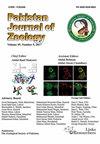巴基斯坦旁遮普省部分家畜养殖场家蝇对杀虫剂的毒性和抗性比较
IF 0.5
4区 生物学
Q4 ZOOLOGY
引用次数: 1
摘要
家蝇是禽类、人类和牲畜设施的一种严重的卫生害虫,具有对化学杀虫剂产生抗药性的巨大能力。本研究旨在评价家蝇对不同种类杀虫剂的敏感性和抗性状况。为此,在巴基斯坦旁遮普省Sargodha区(Sargodha、Khushab、Jauharabad、Mianwali和Bhakkar)的5个不同地点采集家蝇成虫种群,并对选定杀虫剂进行检测。对溴氰菊酯、氟虫腈和毒死蜱的抗性比分别为10.32 ~ 35.37倍、17.49 ~ 38.13倍和10.70 ~ 18.81倍。吡虫啉和吡丙醚的lc50相对危险度分别为4.35 ~ 28.0倍和10.56 ~ 21.45倍。研究表明M。不同地区和不同杀虫剂的家蝇种群。因此,为了控制M。必须通过适当的机制和策略控制家畜设施的家蝇、不适当和过度使用杀虫剂。本文章由计算机程序翻译,如有差异,请以英文原文为准。
Comparative Toxicity and Resistance to Insecticides in Musca domestica from Some Livestock Farms of Punjab, Pakistan
The Musca domestica is a serious hygienic pest of poultry, humans, and livestock facilities with the immense ability for resistance development against chemical insecticides. The current study aimed to evaluate the susceptibility and resistance status of M. domestica against different classes of insecticides. For this purpose, adult M. domestica populations were collected from five different localities of Sargodha division (Sargodha, Khushab, Jauharabad, Mianwali, and Bhakkar), Punjab, Pakistan, and tested against selected insecticides. The resistance ratios (RR) at LC 50 ranged from 10.32-35.37 folds for deltamethrin, 17.49-38.13 folds for fipronil, and 10.70-18.81 folds for chlorpyrifos. The RR values at LC 50 for imidacloprid and pyriproxyfen ranged from 4.35-28.0 and 10.56-21.45 folds, respectively. The study showed varying levels of resistance in M . domestica populations from area to area and from insecticide to insecticide. Therefore, to control resistance development in M . domestica from livestock facilities, inappropriate and excessive use of insecticides must be controlled through proper mechanisms and strategies.
求助全文
通过发布文献求助,成功后即可免费获取论文全文。
去求助
来源期刊

Pakistan Journal of Zoology
生物-动物学
CiteScore
1.10
自引率
16.70%
发文量
306
审稿时长
4.5 months
期刊介绍:
Pakistan Journal of Zoology (Pakistan J. Zool.) publishes original articles in English on all aspects of animal life. Generally these articles will be in, or related to one of the following subject areas: Physiology, Cell Biology, Molecular Biology, Genetics, Bioinformatics, Toxicology, Forensic Science, Developmental Biology, Entomology, Parasitology, Microbiology, Biotechnology, Pathology, Palaeontology. Taxonomy, Environmental Biology, Wildlife, Fisheries, Vertebrate and Invertebrate Morphology. Additionally, the journal considers research on health and clinical studies. Short communications are regularly considered, however, uninvited review articles, first records/reports of known species, case reports/studies and survey reports are not published in Pakistan Journal of Zoology.
 求助内容:
求助内容: 应助结果提醒方式:
应助结果提醒方式:


